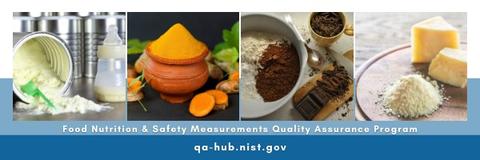Summary
The National Institute of Standards and Technology (NIST) established a Food Nutrition and Safety Measurements Quality Assurance Program (FNSQAP) to support the measurement needs of the food communities. The FNSQAP provides an opportunity for food testing laboratories to improve comparability of their measurements, as well as for NIST to assess community needs for reference materials, workshops, and other measurement services.
Description

As part of a revamp of QAPs in 2021, NIST established the FNSQAP to support the NIST Food Safety Program and Measurements and Standards to Support Nutrition Labeling. Participants measure nutrient components (e.g., minerals, vitamins, fatty acids, dietary fiber) and contaminants (e.g., toxic elements, pesticide residues) in food samples, including infant formula, distributed by NIST. FNSQAP is designed to assist laboratories in the development and validation of new analytical methods, in improving the quality of their analytical measurements, and in supporting compliance with a number of federal regulations enforced by the US FDA, USDA, and other international bodies. Participant data is compiled at NIST and analyzed for accuracy, precision, and concordance within the community. Reports and certificates of completion are sent to participants, and workshops with participating laboratories may be held following future studies. Future FNSQAP studies may address additional food safety areas such as authenticity, protein food allergens, and microbial contaminants, as needs are identified. Please send suggestions for studies or requests for more information regarding FNSQAP and other NIST QAPs to QAPHUB [at] nist.gov (QAPHUB[at]nist[dot]gov).
UPCOMING EXERCISES
Exercise 4
Study | Measurands and Samples |
|---|---|
Toxic Elements | As, Cd, Hg, Pb, and Tl in kale powder and kale/beet powder |
Exercise 4 Invitation Letter
Exercise 4 Shipping Letter
Major Accomplishments
Specific sample/analyte combinations included in each FNSQAP exercise, as well as links to final reports, are summarized in the tables below.
Exercise 1
Study | Measurands and Samples |
|---|---|
Nutritional Elements | Ca, Na, Fe, and K in infant formulas |
Toxic Elements | As, Cd, Pb, and Hg in baby foods |
Water-Soluble Vitamins | Folic acid in infant formulas |
Fat-Soluble Vitamins | Vitamin K in infant formulas |
Contaminants I | Acrylamide in chocolate and coffee |
Contaminants II | Glyphosate in foods |
Exercise 1 Final Report
Exercise 2
Study | Measurands and Samples |
|---|---|
Nutritional Elements | Cr, Mo, and Se in infant formulas |
Toxic Elements | Cd and Pb in chocolate materials |
Water-Soluble Vitamins | Choline and carnitine in infant formulas |
Fat-Soluble Vitamins | Carotenoids in infant formulas |
Fatty Acids | DHA and ARA in infant formulas |
Contaminants I | Glyphosate in turmeric and cat food |
Contaminants II | Phthalates in infant formula and cheese |
Exercise 2 Final Report
Exercise 3
| Study | Measurands and Samples |
|---|---|
| Nutritional Elements | Cu, Mg, and P in infant formulas |
| Water-Soluble Vitamins | Vitamin B12 in infant formulas |
| Fat-Soluble Vitamins | Vitamin A in infant formulas |
| Contaminants I | PFAS in meat, milk, and egg |
| Contaminants II | Pesticides in spinach |
Exercise 3 Final Report
Associated Publications
1. Jahrman, E. P., Yu, L. L., Krekelberg, W. P., Sheen, D. A., Allison, T. C., and Molloy, J. L., "Assessing arsenic species in foods using regularized linear regression of the arsenic K-edge X-ray absorption near edge structure," Journal of Analytical Atomic Spectrometry, 37, 1247-1258 (2022).
2. Cruz, M. B., Place, B. J., Wood, L. J., Urbas, A., Wasik, A., and Rocha, W. F. D., "A nontargeted approach to determine the authenticity ofGinkgo bilobaL. plant materials and dried leaf extracts by liquid chromatography-high-resolution mass spectrometry (LC-HRMS) and chemometrics," Analytical and Bioanalytical Chemistry, 412, 6969-6982 (2020).
3. Heck, M. and Neely, B. A., "Proteomics in Non-model Organisms: A New Analytical Frontier," Journal of Proteome Research, 19, 3595-3606 (2020).
4. Phillips, M. and Zhang, K., "Mycotoxins and Food Safety-Prevention and Control: Expectation and Reality," Journal of Aoac International, 102, 1641 (2019).
5. Yu, L. L., Browning, J. F., Burdette, C. Q., Caceres, G. C., Chieh, K. D., Davis, W. C., Kassim, B. L., Long, S. E., Murphy, K. E., Oflaz, R., Paul, R. L., Sharpless, K. E., Wood, L. J., Yen, J. H., and Zeisler, R., "Development of a kelp powder (Thallus laminariae) Standard Reference Material," Analytical and Bioanalytical Chemistry, 410, 1265-1278 (2018).
6. Wise, S., "CCQM activities and impact in food safety and nutrition," Abstracts of Papers of the American Chemical Society, 250, (2015).
7. Sharpless, K. E., Thomas, J. B., Duewer, D. L., Putzbach, K., Rimmer, C. A., Sander, L. C., Schantz, M. M., Wise, S. A., Yarita, T., and Yen, J. H., "Preparation and characterization of standard reference material 3276, carrot extract in oil," Analytical and Bioanalytical Chemistry, 389, 207-217 (2007).
8. Sander, L. C., Sharpless, K. E., and Wise, S. A., "Dietary supplement Standard Reference Materials," Life Sciences, 78, 2044-2048 (2006).
9. Sharpless, K. E., Anderson, D. L., Betz, J. M., Butler, T. A., Capar, S. G., Cheng, J., Fraser, C. A., Gardner, G., Gay, M. L., Howell, D. W., Ihara, T., Khan, M. A., Lam, J. W., Long, S. E., McCooeye, M., Mackey, E. A., Mindak, W. R., Mitvalsky, S., Murphy, K. E., NguyenPho, A., Phinney, K. W., Porter, B. J., Roman, M., Sander, L. C., Satterfield, M. B., Scriver, C., Sturgeon, R., Thomas, J. B., Vocke, R. D., Wise, S. A., Wood, L. J., Yang, L., Yen, J. H., and Ziobro, G. C., "Preparation and characterization of a suite of ephedra-containing standard reference materials," Journal of Aoac International, 89, 1483-1495 (2006).

